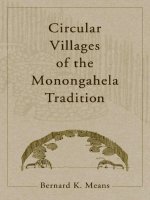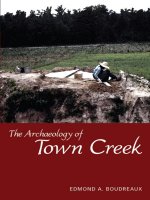university alabama press plaquemine archaeology dec 2006
Bạn đang xem bản rút gọn của tài liệu. Xem và tải ngay bản đầy đủ của tài liệu tại đây (2.42 MB, 282 trang )
Plaquemine Archaeology
A Dan Josselyn Memorial Publication
Plaquemine Archaeology
Edited by Mark A. Rees and Patrick C. Livingood
the university of alabama press
Tuscaloosa
Copyright © 2007
The University of Alabama Press
Tuscaloosa, Alabama 35487-0380
All rights reserved
Manufactured in the United States of America
Typeface: AGaramond and Triplex
∞
The paper on which this book is printed meets the minimum requirements of American
National Standard for Information Sciences-Permanence of Paper for Printed Library
Materials, ANSI Z39.48-1984.
Library of Congress Cataloging-in-Publication Data
Plaquemine archaeology / edited by Mark A. Rees and Patrick C. Livingood.
p. cm.
Includes bibliographical references and index.
ISBN-13: 978-0-8173-1543-6 (cloth : alk. paper)
ISBN-10: 0-8173-1543-8 (alk. paper)
ISBN-13: 978-0-8173-5366-7 (pbk. : alk. paper)
ISBN-10: 0-8173-5366-6 (alk. paper)
1. Plaquemine culture. 2. Mounds—Louisiana. 3. Mounds—Mississippi. 4. Plaquemine
pottery—Louisiana. 5. Plaquemine pottery—Mississippi. 6. Excavations (Archaeology)—
Louisiana. 7. Excavations (Archaeology)—Mississippi. 8. Louisiana—Antiquities.
9. Mississippi—Antiquities. I. Rees, Mark A. II. Livingood, Patrick C.
E99.P635P57 2007
976′.01—dc22
2006016065
Figures vii
Tables xi
Preface xiii
1. Introduction and Historical Overview / Mark A. Rees and Patrick
C. Livingood 1
2. Coles Creek Antecedents of Plaquemine Mound Construction:
Evidence from the Raffman Site / Lori Roe 20
3. Extraregional Contact and Cultural Interaction at the Coles
Creek–Plaquemine Transition: Recent Data from the Lake Providence
Mounds, East Carroll Parish, Louisiana / Douglas C. Wells and
Richard A. Weinstein 38
4. Plaquemine Mounds of the Western Atchafalaya Basin /
Mark A. Rees 66
5. Transitional Coles Creek–Plaquemine Relationships on Northwest
Lake Salvador, St. Charles Parish, Louisiana / Malcolm
K. Shuman 94
6. Plaquemine Recipes: Using Computer-Assisted Petrographic
Analysis to Investigate Plaquemine Ceramic Recipes /
Patrick C. Livingood 108
7. Feasting on the Bluffs: Anna Site Excavations in the Natchez Bluffs of
Mississippi / Virgil Roy Beasley III 127
8. Plaquemine Culture in the Natchez Bluffs Region of Mississippi /
Ian W. Brown 145
9. The Outer Limits of Plaquemine Culture: A View from the Northerly
Borderlands / Marvin D. Jeter 161
Contents
10. Contemplating Plaquemine Culture / Tristram R. Kidder 196
References Cited 207
Contributors 259
Index 261
vi contents
1.1. The Lower Mississippi Valley, showing the major drainages and re-
gions discussed in the text 2
1.2. Areas discussed by individual authors 16
2.1. Core Coles Creek region and locations of most sites discussed in
the chapter 22
2.2. Middle Woodland through Historic phase chronology for the central
Lower Mississippi Valley 23
2.3. The Raffman site, showing locations of 1998 through
2004 excavations 27
2.4. Mound B at Raffman, showing locations of excavations and
soil cores 33
3.1. Location of the Lake Providence Mounds 39
3.2. Contour map of the Lake Providence Mounds, showing the four ex-
tant mounds and the Corps’ right-of-way during the 1998–1999 data-
recovery program 40
3.3. Pro¤les of north and east walls of TU N80W79 showing the three
construction stages revealed during excavation 41
3.4. Plan of wall trenches and postholes associated with the Preston phase
in Block 1, showing evidence of the three building episodes believed to
have been present 43
3.5. Date ranges of the seven Coles Creek occupations recognized at
Lake Providence 44
3.6. Proposed site-formation sequence at Lake Providence 45
3.7. Ceramics normally thought to be representative of the Balmoral and
Routh phases but clearly part of the Preston phase component at Lake
Providence 47
Figures
3.8. Preston phase ceramics from Lake Providence 48
3.9. Additional Preston phase ceramics from Lake Providence 49
3.10. Ceramic types and varieties of the Balmoral, Preston, and
Routh phases 50
3.11. Examples of pottery associated with the “Preston ¤neware
complex” 51
3.12. Sherds of the Powell and Coker sets recovered at Lake
Providence 53
3.13. Additional artifacts suggestive of contact with the American Bottom
region 54
3.14. Depiction of Early Mississippian in®uences on the Yazoo Basin during
the Crippen Point phase 55
3.15. Chronology chart illustrating the temporal relationship of archaeologi-
cal phases in the Tensas Basin and American Bottom regions since
about a.d. 750 59
4.1. South-central Louisiana, showing the locations of major Plaquemine
mound sites 73
4.2. Site 16SL3 74
4.3. Site 16SM38 77
4.4. Site 16SM5 81
4.5. Site 16SMY10 85
5.1. Lake Salvador and archaeological sites mentioned in
the chapter 98
6.1. Plane-polarized scan of PRP27 115
6.2. Cross-polarized scan of PRP27 115
6.3. Example of a false-color enhanced image of the cross-polarized scan
for PRP27 115
6.4. Boolean image of the shell and shell void identi¤cations
for PRP27 115
6.5. Biplot of grog and shell percentages 120
viii figures
6.6. Biplot of grog and shell percentages showing clusters determined by
analysis of the petrographic data 122
7.1. Location of Anna site 128
7.2. Site map of Anna Mounds group 131
7.3. Neo-Indian chronology in the Lower Yazoo Basin and Natchez Bluffs
region of the Lower Mississippi Valley 135
7.4. Plan view, Block 1 excavations 139
7.5. Chicot Red, var. Fairchild vessel 140
7.6. Addis Plain, var. Addis vessel 140
8.1. Selected Plaquemine sites in the Natchez Bluffs region
of Mississippi 146
9.1. Southeast Arkansas, showing major streams, county boundaries, and
locations of some key sites mentioned in the chapter 164
9.2. The Bellaire “serpent-cat” pipe 168
9.3. Addis Plain bowl with deeply notched rim from the Boydell site in
southeast Arkansas 173
figures ix
2.1. Radiocarbon dates from the Raffman site 29
3.1. Proveniences of samples and results of sourcing analysis on selected
Lake Providence sherds 57
4.1. Radiocarbon dates from mound sites in the western
Atchafalaya Basin 79
6.1. Samples used in the analysis 118
6.2. Description of the temper clusters 125
7.1. Faunal MNI and estimated meat yields from Foster
phase surface 137
Tables
I wish I could be sure when I ¤rst encountered the term Plaquemine, but it
cannot be less than 50 years ago. Probably it occurred when I was in Ann
Arbor in 1949–1950 with Jimmy Grif¤n, although I trust that my earlier Yale
mentor, Ben Rouse, could not have been ignorant of it either, due to his amaz-
ingly broad knowledge of world archaeology and his having been the editor
of American Antiquity. In the text herein, I am cited as using the term in a
1956 article! Wow, how little one remembers of one’s own past.
However, we Lower Valley scholars must not be too brazen in our knowl-
edge and usage. I am sure that we cannot make Plaquemine a broadly known
term in the eastern United States or even in the southeastern corner of our
nation. But we can take heart from other quite well-known terminology and
realize that every area in American archaeology has its own best-known
words: “Clovis and Pecos” for New Mexico, “Cahokia” for Illinois, “Hope-
wellian” for Ohio, and so on. So why not “Plaquemine,” then, for a culture
in the southern part of the Lower Mississippi Valley, named for a town in
Louisiana?
Of course, I do support large overviews from the elders. My own introduc-
tion to the Lower Mississippi Valley began even before Ann Arbor in the
1950s; it actually began with a December 1948 visit to the Sandy Woods site
in southeast Missouri with my father and my twin brother, Philip. I had been
working in the Yale Peabody Museum on an archaeological collection from
that site for my Senior Honors paper. I grew up—one through ¤ve years—on
the very banks of the Mississippi River in Minneapolis.
But enough of the past. From southeast Missouri the whole Lower Missis-
sippi Valley lay ahead for me: Nodena in northeast Arkansas, the Lake George
site in the Yazoo Basin, and also much farther south still with the Lower Mis-
Preface
sissippi Survey through Louisiana, only ending at Avery Island on the Gulf of
Mexico. The Lower Mississippi Survey from the Harvard Peabody Museum
has been there and done that, starting with Phil Phillips’s work in the late
19 30 s .
So back to Plaquemine: this volume provides a very good coverage on the
topic, and there is not too much more that I can add. When the readers ¤nish
this lengthy discussion on Plaquemine I think they will have learned quite a
lot of useful information on this perennially discussed topic.
Stephen Williams, Professor Emeritus
Harvard University
xiv preface
The town of Plaquemine, Louisiana, seems an unassuming southern commu-
nity for which to designate an entire culture. Of course names can be mis-
leading and Plaquemine is no exception. Like Mississippian culture of south-
eastern North America, of which Plaquemine has been described as a regional
focus or variant (Grif¤n 1946, 1967), Plaquemine was devised by archaeolo-
gists to describe the material remains and sites of pre-Columbian and proto-
historic Native American societies for which there exists little or no written
documentation. Its geographic position has been associated with the Lower
Mississippi Valley (LMV), extending from the Mississippi delta on the Gulf
coast to just south of the Arkansas River (Jeter and Williams 1989:207–208;
cf. Neuman 1984:259). This area spans the southern Yazoo Basin and Natchez
Bluffs on the east and the lower Ouachita and Red river valleys on the west,
encompassing a diverse range of valley topography and environments (Figure
1.1) (Autin et al. 1991; Kidder 2004b:545; Saucier 1994).
So what’s the problem or, rather, what are the problems with Plaquemine?
Like the town for which it was named, it has seemed at times on the verge of
washing into the Mississippi River (Riffel 1985:38–41). Unlike its more well-
known and extroverted Mississippian cousin, Plaquemine seems to have been
fraught with dif¤culties since early on. No sooner had the concept been de-
¤ned than the exigencies of archaeological research required that it be decon-
structed and rede¤ned (Phillips 1970:950). Alternating descriptions of diag-
nostic pottery types, earthen mounds, and architecture in different regions
have produced the appearance of an imprecise or “nebulous” tradition (Brown
1985b:252; Jeter and Williams 1989:205). Yet Plaquemine is today still regarded
as a distinct cultural tradition on the frontier of the Mississippian world, with
ties to both earlier Coles Creek and contemporaneous Mississippian tradi-
1
Introduction and Historical Overview
Mark A. Rees and Patrick C. Livingood
Figure 1.1. The Lower Mississippi Valley, showing the major drainages and regions discussed
in the text.
tions, beginning in the second or third century of the Mississippi period (ca.
a.d. 1000–1700).
As advances in research continue to make contributions to our understand-
ing of the archaeology of the LMV, it is apropos to reconsider the concept of
Plaquemine culture. An attempt has been made in this volume to draw to-
gether recent studies that call attention to variability as well as uniformity,
including views from such disparate environments as the Mississippi River
®oodplain, the Tensas Basin, the Natchez Bluffs, and the “northerly border-
lands” of southeastern Arkansas. Even so, much variability in the archaeologi-
cal record has yet to be adequately investigated. There is little doubt that
Plaquemine will continue to serve on one level as a valuable heuristic in ex-
amining and making sense of that variability. This chapter examines the ori-
gins and de¤nitions of Plaquemine, summarizes some of the history and
themes of Plaquemine archaeology, and introduces some ongoing problems
and directions for future research.
Historical Genesis and Adjustments
Plaquemine ¤rst appeared in print in James Ford and Gordon Willey’s classic
1941 synthesis of eastern United States prehistory, although without further
consideration in the text. Plaquemine was shown to be intermediate to the
preceding Coles Creek period and subsequent Natchez and Bayou Goula cul-
tures. The embryonic nature of the concept is illustrated in the atypical spell-
ing (“Placquemine”) in two chronological pro¤les (Ford and Willey 1941:Fig-
ures 2 and 6). Ford and Willey (1941:359) also cited the Bayou Goula report
as “in preparation” by Quimby. “Placquemine” was portrayed by Ford and
Willey (1941:328, 330) as transitional between the Temple Mound I and II
stages along the north–south axis of eastern North American cultures and
associated with the Temple Mound II stage in the east–west axis. The Temple
Mound stage terminology was eventually superseded by the Mississippi pe-
riod and Plaquemine would come to be de¤ned by way of contrast (Grif¤n
1946, 1967; Williams 1956; cf. Willey 1966:292–304).
The origins of Plaquemine can ultimately be traced to a series of distinc-
tions made during the ¤rst half of the twentieth century, distinctions that at
least initially had little to do with Plaquemine. Surveying the geographic dis-
tributions of Native American pottery in the eastern United States a century
ago, William Henry Holmes (1903:21) predicted that the groups of pottery he
laid out contained suf¤cient internal variability to eventually warrant further
subdivision (see also Moore 1913). Holmes (1886, 1903) was instrumental in
the creation of the Mississippian concept via his “Middle Mississippi Valley
introduction a nd historica l overv iew 3
group,” which by mid-century had become ¤rmly established as the late pre-
Columbian and protohistoric period in the Southeast, as well as a precocious
and expansive culture subsequently thought to have emanated from the Cen-
tral Mississippi Valley (DeJarnette and Wimberly 1941:99–110; Grif¤n 1943:257,
1946, 1952; Phillips et al. 1951; Williams 1956; see Grif¤n 1985 for an overview).
Holmes (1903:21) suggested that ceramic traditions do not inevitably coincide
with ethnicity or culture, nor are they always a reliable measure of cultural
complexity (i.e., “important groups” versus “insigni¤cant communities”). He
described the geographic distribution, function, stylistic variation, and tem-
per of pottery in the Mississippi Valley, including the physical properties of
shell temper and general similarities between Lower and Middle Mississippi
wares (Holmes 1903:20–80, 101–104). Mississippian culture and the Missis-
sippi period were derived from this and subsequent works in the context of an
emergent culture historical archaeology in the Southeast (Grif¤n 1985:44–57).
Plaquemine was developed by James Ford and George Quimby based on
the results of WPA work conducted between 1938 and 1941 under the auspices
of the Louisiana State Archaeological Survey. It represented a re¤nement of
Ford’s (1935a, 1936, 1938) earlier chronology of ceramic-producing cultures in
the LMV: Marksville, Coles Creek, and Natchez (Quimby 1942:256, 1951:87).
In an article completed the same year Ford and Willey’s overview was publish-
ed (1941), Quimby (1942:256) de¤ned Plaquemine as a “culture which pre-
ceded the Natchezan type.” Like Mississippian, Plaquemine had its roots in
more fundamental pottery typologies and their chronological classi¤cation.
More than any other culture trait, pottery types were seen as central in
distinguishing Natchez from contemporaneous and earlier cultures. Among
the types initially regarded by Quimby (1942:265–268) as characteristic of a
“Plaquemine period” were Addis Plain (Baytown Plain, var. Addis), Manchac
Incised (Mazique Incised, var. Manchac), Hardy Incised (Coles Creek Incised,
var. Hardy), Plaquemine Brushed, Pocahontas Plain (Mississippi Plain, var.
Pocahontas), and Pocahontas Punctated, the latter two types subsequently as-
sociated more strictly with the Natchez Bluffs (e.g., Neitzel 1983:95).
Coles Creek was in effect split into thirds: Troyville, Coles Creek proper,
and Plaquemine. Plaquemine was also envisioned as a spatially intermediate
pottery complex, wedged between Caddo sites on the west and various Mis-
sissippian complexes farther north and east (Ford and Willey 1941:328, 330).
In this sense, Plaquemine was initially conceptualized as “a logical correction
for the hasty 1940 overextension of the Caddoan concept, rather than an out-
growth of it” (Jeter and Williams 1989:205; cf. Phillips 1970:946). Plaquemine
thus came into being as a somewhat vague designation for post–Coles Creek,
4 rees and livingood
pre-Natchez, non-Caddo, and non-Mississippian pottery assemblages in the
Lower Valley (Brown 1985b:252; Jeter and Williams 1989:205; Quimby 1942:256).
Plaquemine consequently received the dubious distinction early on of being
“de¤ned more in terms of what it lacks than in what it possesses” ( Jennings
1952:267).
Archaeological understanding of Plaquemine components and assemblages
advanced slowly during the ensuing decades, despite the fact that it was never
“adequately de¤ned” as a culture (Williams and Brain 1983:373). As it turns
out, 1951 was a seminal year for publications on Plaquemine as well as Missis-
sippian archaeology (e.g., Cotter 1951a; Ford 1951; Phillips et al. 1951; Quimby
1951). Sites such as Greenhouse, Medora, Emerald, and Anna yielded a wealth
of information with which to ®esh out the concept of Plaquemine culture.
With the addition of publications by Cotter (1952a) and Quimby (1957) on
the Gordon and Bayou Goula sites, these works made up until the early 1970s,
according to Phillips (1970:950), the “basic documentation for the Plaque-
mine culture period” (see also Belmont 1967; Bohannon 1963; Brain 1969;
Hally 1967; Neitzel 1965). The rapid appearance of these groundbreaking
publications, delayed by World War II, provided the impetus for examin-
ing internal variability in respect to pottery types and the rede¤nition of
Plaquemine-related phases (Phillips 1970:950). Ironically, it would also in®u-
ence consideration of similarities between regional variants of Plaquemine
culture and Coles Creek, Mississippian, Natchez, and Caddo cultures, or pre-
cisely what had made it necessary to differentiate Plaquemine in the ¤rst place
(e.g., Brain 1978; Brown 1985a, 1985b; Gregory 1969; Hally 1972; Neitzel 1965,
1983; Steponaitis 1981; Webb 1959, 1961).
Quimby’s (1951) Medora site report is generally cited as establishing the
formal, archaeological criteria for both Plaquemine culture and a Plaquemine
period (e.g., Ford 1952:327; Jeter and Williams 1989:206; Phillips 1970:950).
Quimby argued that speci¤c ceramic types such as Addis Plain (Baytown
Plain, var. Addis), Plaquemine Brushed, L’Eau Noire Incised, Manchac In-
cised (Mazique Incised, var. Manchac), Hardy Incised (Coles Creek Incised,
var. Hardy), and others are integral to the de¤nition of the Plaquemine con-
cept. Certain ceramic vessel forms such as plates with interior incising and jars
with brushed decoration remain key Plaquemine indicators. Because the re-
port was based on excavation and not just surface collections, he was also able
to suggest other traits that characterize Plaquemine (Quimby 1951:128). Some
of these, such as the presence of truncated, pyramidal mounds around a plaza
and post construction with and without wall trenches, have generally held up
over time.
introduction a nd historica l overv iew 5
Like most chronologies proposed before radiocarbon dating was available,
the original dates for Plaquemine turned out to be too short and too recent.
Originally thought to date not much earlier than a.d. 1400–1500 (Ford and
Willey 1941:328, 330; Quimby 1951:130, 1957), it is now commonly considered
to date from at least a.d. 1200. Phillips, Ford, and Grif¤n (1951:454, Table 17)
suggested as much in the conclusion of their monumental Archaeological Sur-
vey in the Lower Mississippi Alluvial Valley, based on the correlation of sites
with Mississippi River channel chronology. Plaquemine was preceded accord-
ing to some by a Coles Creek transition (a.d. 1000–1200; Jeter and Williams
1989:172; Weinstein and Kelley 1992:31, 38). Medora, the type site for Plaque-
mine culture, in fact appears to date in large part from this transitional era
(Brown 1985b:256; Weinstein 1987a:87–90). Plaquemine culture is now also
usually placed within the Mississippi period (rather than Quimby’s Plaque-
mine period), re®ecting the greater in®uence of Mississippian culture and
Mississippian archaeology (Brown 1998e).
Plaquemine Origins Reconsidered
There remain substantial differences of opinion concerning Plaquemine cul-
tural origins, particularly in relation to preceding Coles Creek and contempo-
raneous Mississippian traditions. At the risk of oversimplifying the present
state of affairs, three lines of argument generally characterize these differences.
The ¤rst is represented in the formative works of Ford (1951), Quimby (1942,
1951, 1957), and Phillips (1970) and is referred to here as “neither Mississippian
nor Coles Creek.” In contrast, the second has been described as “Mississip-
pianized Coles Creek” (Brain 1978:344–345; Brown 1985b:253; Williams and
Brain 1983), while a third approach represents a middle ground of sorts and
might be characterized as endogenous development or “continuity and change”
(Kidder 1998b:131, this volume). Although there is certainly room for compro-
mise (e.g., Kelley et al. 2000:17–18; Weinstein 1987a:87), we use these distinc-
tions here as a means of highlighting the diversity of Plaquemine through
time and space.
Neither Mississippian nor Coles Creek
Phillips (1970) both emphasized the position of Plaquemine as a culture and
rede¤ned the culture in terms of speci¤c phases. This allowed him to talk
about the Mississippi period throughout the LMV but to distinguish between
Plaquemine and Mississippian cultures. Phillips re¤ned and codi¤ed the type-
variety system used for classifying ceramics in the Lower Valley. One of the
hallmarks of this system is that it is hierarchical; it calls for investing more
6 rees and liv ingood
importance in certain distinctions by using them as the criteria to separate
types, and it calls for subsuming other, presumably more minor differences
under the divisions between varieties (e.g., Brown 1998b). The presence or
absence of shell tempering was recognized as one of the ¤rst-order distinctions
used in the descriptions of types. Since Phillips used ceramic evidence as the
primary criteria for making cultural distinctions, the absence or presence of
shell tempering became the axiomatic means for separating Plaquemine from
Mississippian (Kidder 1998b:131; Williams and Brain 1983:337, 340).
The de¤nition of Plaquemine we inherit from Phillips (1970:30, 34) thus
hinges almost entirely on ceramics. He stipulated that Plaquemine is de¤ned
by a cluster of ceramic types and forms, the absence of signi¤cant shell tem-
pering being the most important characteristic that ties these complexes to-
gether. Plaquemine is distinguished by “long-standing typological criteria”
developed out of Phillips, Ford, and Grif¤n’s (1951) earlier Archaeological Sur-
vey in the Lower Mississippi Alluvial Valley (Phillips 1970:923). Phases as well
as cultures were distinguished on the basis of ceramics, according to Phillips
(1970:9) representing “discontinuities of a minor order that are no less inher-
ent in the material.”
Phases were consequently emphasized as the central mechanism for under-
standing cultural dynamics, as embodied in regional designations such as Me-
dora, Crippen Point, and Fitzhugh (Phillips 1970:558–560, 945, 950–951; cf.
Phillips and Willey 1953). Phillips (1970:950–951) thus commented on the
phase-based “dismemberment” of Plaquemine culture as a necessary analyti-
cal exercise, excising all except those phases that maintained Plaquemine as a
cohesive and unadulterated complex. Of course, one result of this approach
was to emphasize the need to determine whether a particular phase was either
Plaquemine or Mississippian (Jeter and Williams 1989:212). On a broader
scale, Phillips (1970:13) described Mississippian in®uence in the Lower Yazoo
Basin in terms of intrinsic cultural movements, falling somewhere between
diffusion and invasion. He referred to the ability of Plaquemine culture bear-
ers to repel, at least for a time, the seemingly indomitable Mississippian drive
southward (“Drang nach Süden”; Phillips 1970:954), what a later generation
of archaeologists would critique as the “Mississippian expansion” (i.e., Smith
1984).
The idea of Plaquemine as neither Mississippian nor Coles Creek was thus
integral to its origin as an archaeological culture, pottery complex, culture
period, and phase. Ford (1951:85–89) found only minor evidence for an early
Plaquemine component at Greenhouse, a major Coles Creek mound site in
central Louisiana. Similarities between Plaquemine and Coles Creek were
introduction a nd historica l overv iew 7
seen as strongest in this area and to the south, both in terms of pottery types
and the continued use of burial mounds (e.g., Jennings 1952:267; Rees, this
volume). In contrast, similarities between Plaquemine and Mississippian were
more readily apparent to the north, particularly at sites with large platform
mounds. Yet perceptions of difference and similarity had actually provided
little explanation for Plaquemine cultural origins. Near the end of his Yazoo
Basin report, Phillips (1970:967–968) amended an earlier suggestion that
Plaquemine architecture and settlement patterns in the Yazoo Basin appeared
to represent the “Mississippianization” of Plaquemine culture, arguing instead
that “the hypothesis can only be tested by thorough excavation.”
Mississippianized Coles Creek
Following Phillips’s prescient advice, Stephen Williams and Jeffrey Brain re-
formulated and advanced the concept of Plaquemine in several key ways from
the vantage point of the Lower Yazoo Basin (Brain 1978, 1989, 1991; Williams
and Brain 1983). They produced the most coherent and far-reaching interpre-
tation of Plaquemine cultural origins and development by arguing that Plaque-
mine could be best viewed as “a hybridization of Coles Creek and Mississip-
pian cultures” (Williams and Brain 1983:338). On the basis of the results of
investigations at Lake George and Winterville, they argued that during the
Coles Creek period LMV residents, especially in frontier zones, began to
adopt new technologies with Mississippian origins, such as shell tempering,
the Mississippian jar, and wall-trench houses (Brain 1969, 1989:114–120; Wil-
liams and Brain 1983:408–414). This was followed by the encroachment of
small numbers of Mississippian communities into the northern part of the
Yazoo Basin, at sites such as Buford. By a.d. 1200 direct person-to-person
contacts were occurring between major Mississippian settlements to the north
and major sites in the Lower Valley. Between a.d. 1300 and 1400 sites in
the Lower Yazoo began to be acculturated to the Mississippian pattern and
more closely resembled sites farther north (Brain 1989:125, 128). As a result, a
Mississippian/Plaquemine frontier formed and moved south. Prior to a.d. 1300
it was somewhere north of Greenville, Mississippi, but by a.d. 1400–1500 the
frontier had moved to the vicinity of Vicksburg. Plaquemine was conse-
quently de¤ned as the Mississippianization of Coles Creek culture, a concept
that has more recently undergone historical-processual revision (Brain 1989:122;
e.g., Pauketat 2002, 2004).
Williams and Brain further amended the de¤nition of Plaquemine by re-
classifying the Crippen Point phase as terminal Coles Creek instead of early
8 rees and livingood
Plaquemine, thus moving the Coles Creek–Plaquemine transition from about
a.d. 1000 to a.d. 1200. Phillips (1970:558–560) had originally classi¤ed Crip-
pen Point as Plaquemine because it was associated with the appearance of
Addis-paste ceramics. However, Williams and Brain (1983:318) argued that
Crippen Point ceramics continued to exhibit linear decorative techniques fo-
cused on the vessel rim, like most previous Coles Creek forms. Beyond ceram-
ics, they pointed out that the Lake George site underwent only small, gradual
changes during the Crippen Point phase, placing it more comfortably within
the preceding Coles Creek period.
As Jeter and Williams (1989:208–209) indicate, the reformulation of the
Coles Creek–Plaquemine transition has far-reaching consequences for how
we characterize the late prehistory of the Lower Valley. If the Crippen Point
phase is categorized as Coles Creek, then Williams and Brain (1983:405) are
correct in describing Coles Creek as a relatively conservative period followed
by dramatic changes, including the abrupt adoption of Mississippian tech-
nologies. Plaquemine is in effect the culmination of Mississippian cultural
in®uences upon conservative Coles Creek societies. Alternatively, if the Crip-
pen Point phase is categorized as Plaquemine, then the origins of Plaque-
mine culture predate major Mississippian in®uence and changes appear more
gradual.
Outside the Lower Yazoo Basin, researchers have faced related dif¤culties
in classifying phases according to broader cultural categories. For example,
there have been disagreements over whether to classify the Bayou Petre phase
in the Mississippi delta as either Mississippian or Plaquemine (Brown 1985b:283;
Phillips 1970:951–953; Weinstein 1987a:98). Differences of opinion have also
arisen regarding the Preston phase in the Tensas Basin and whether or not to
classify it as Coles Creek (Hally 1972:605–607; Jeter and Williams 1989:210–
212; Wells and Weinstein 2005). Such decisions ultimately transcend differ-
ences regarding which period or culture a certain phase should be associated
and strike at the heart of how we conceive of Plaquemine. Faced with the
ambiguities of drawing an exact boundary between Coles Creek and Plaque-
mine where none appears to exist, some scholars have instead advocated using
“transitional Coles Creek–Plaquemine” to refer to intermediate phases such
as Crippen Point, Gordon, Preston, and St. Gabriel (Belmont 1982a; Belmont
and Williams 1981; Brown 1985b; Jeter and Williams 1989; Weinstein 1987a;
Wells and Weinstein, this volume). In doing so, the question of Plaquemine
origins is effectively rephrased as a problem of understanding continuity and
change.
introduction a nd historica l overv iew 9
Continuity and Change
An alternative approach to Plaquemine origins is to describe it as an endo-
genous cultural tradition or outgrowth of preceding Coles Creek culture, with
no less signi¤cant exogenous in®uences (Haag 1965:304–307, 1978, 1988; Hally
1972; Kidder 1998b; Neuman 1984:258; Sibley 1967:157). From this perspec-
tive, interpretations of Plaquemine culture as “Mississippianized Coles Creek”
rely too heavily on the Lower Yazoo data and do not generalize well to other
regions such as the Lower Ouachita, Tensas Basin, or Natchez Bluffs (Kidder
1998b:131). In fact, there is little evidence from Plaquemine components in
areas far removed from the Lower Yazoo Basin for direct contacts or similar
wide-ranging Mississippian in®uence (e.g., Quimby 1951; Rees 2003, this vol-
ume). Despite the fact that communities in regions closer to the Lower Yazoo
Basin adopted similar site plans and ceramic forms, it seems unrealistic to
consider all Plaquemine components throughout the LMV as Mississippian-
ized Coles Creek (Brown 1985b; Hally 1972).
When Mississippian contacts have been identi¤ed in other regions it has
been in juxtaposition with a clear progression from Coles Creek to Plaque-
mine traditions (Brown 1999; Davis and Giardino 1980; Weinstein 1987a,
1987b; Weinstein and Kelley 1984; Wells and Weinstein, this volume). For
example, Mississippian in®uences from the Mobile Bay region via the Bayou
Petre phase have been identi¤ed for a coastal Plaquemine variant represented
in the Barataria and Burk Hill phases (Brown 1985b; Brown et al. 1979; Davis
1984; Jeter and Williams 1989:218–220; Shuman, this volume; Weinstein
1987a). It should come as no surprise, then, that Caddo in®uence has likewise
been discerned for Plaquemine phases on the western “frontier” ( Jeter and
Williams 1989:213; Rolingson 1976). Similarities between Caddo and Plaque-
mine ceramic assemblages were recognized early on by Grif¤n (1946:83), Krie-
ger (1946:253, 255), and Webb (1959:148, 150, 153, 202, 206), supposedly based
on a common Coles Creek derivation (see also Sibley 1967:157–164). Despite
differences of opinion, many archaeologists now recognize clear continuities
between Coles Creek and Plaquemine traditions (Brown 1984:115, 118; Kelley
1984:43; Miller et al. 2000:47; Ryan, ed. 2004:23–24; Weinstein 1987a:87;
Wells 2001:16).
Regarding the “typological criteria” set forth by Phillips (1970:923), David
Hally (1972) has suggested that archaeologists may be placing too much im-
portance on the appearance of shell tempering. T. R. Kidder (1998b:132) has
likewise suggested that an emphasis on shell tempering might be creating an
“arti¤cial dichotomy between Mississippian and Plaquemine cultures and
10 rees and livingood









